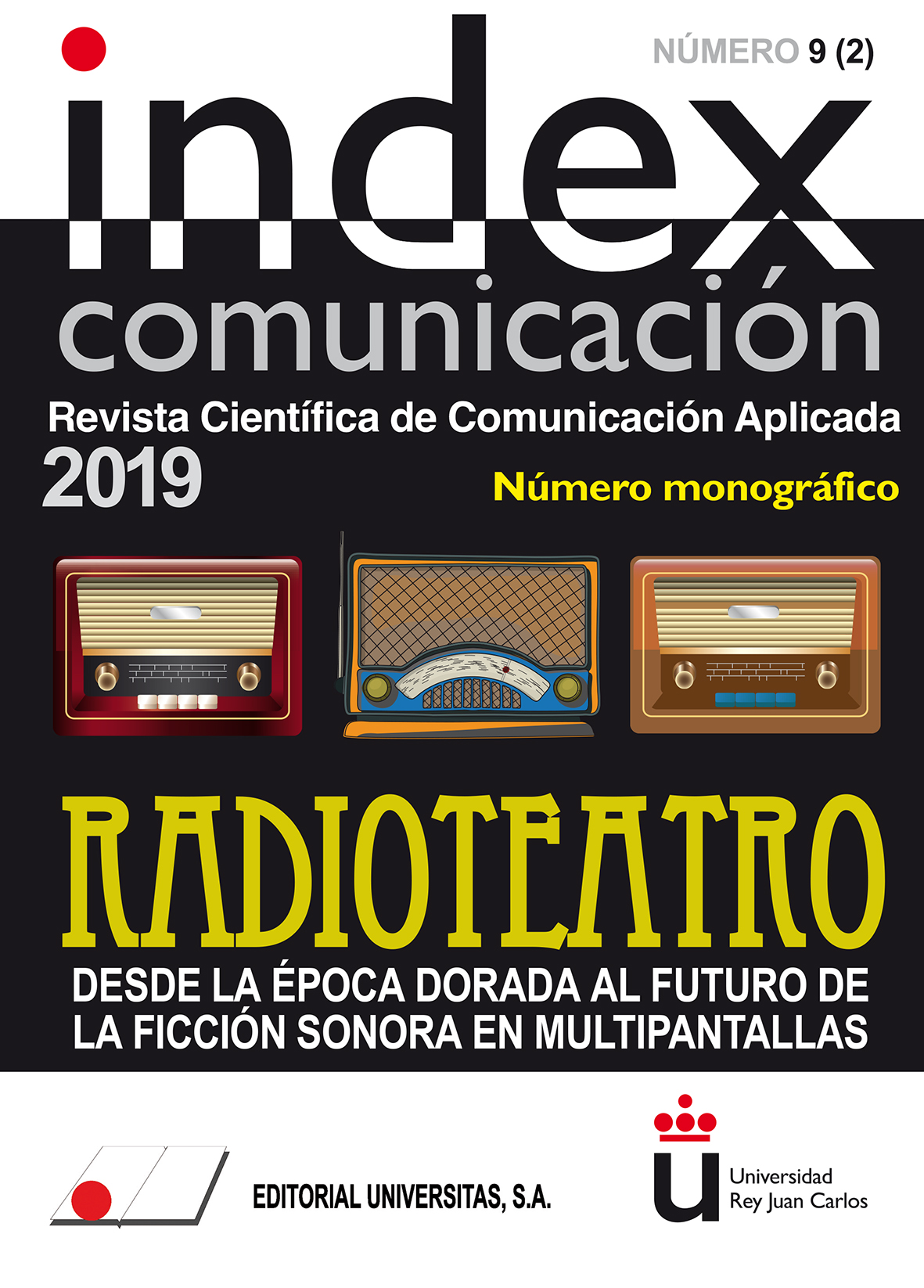Radio Theatre in Italy. Storytelling between Public Service Broadcasting and New Digital Spaces
DOI:
https://doi.org/10.33732/ixc/09/02RadiotKeywords:
Radio Theatre, Media Narratives, Social and Cultural Inclusion, Social Cohesion, innovation, digital renaissanceAbstract
This paper analyzes Italian radio theatre evolution and its ability to put itself always in the middle between radio and other expressive media: theater, cinema, comics, daily news, books and Internet. Starting from the analysis of the main evolutionary phases of this complex radio genre, this contribution illustrates the complexity of radio theater as one of the treasures brought to light by media archeology, which lends itself almost naturally to disciplinary and media crossings. In this expressive format, belonging to media proto history, lurks a deeply complex nature and fervent creativity, which rediscovers in the ether an amplifier of the digital, a new space of expressiveness and diversification of its audience.
Metrics
References
ARNHEIM, R. (1937). La radio cerca la sua forma. Milano: Hoepli.
ARNHEIM, R. (2003). La radio, L’arte dell’ascolto e altri saggi. Roma: Editori Riuniti.
BARTHES, R. (1986). La grana della voce. Interviste 1962-1980. Torino: Einaudi.
BRECHT, B. (1975). Scritti sulla letteratura e sull’arte. Torino: Einaudi.
BENJAMIN, W. (1974). Il dramma barocco tedesco. Torino: Einaudi.
BENJAMIN, W. (1979). Autore come produttore. Avanguardia e rivoluzione. Saggi sulla letteratura. Torino: Einaudi.
BONINI, T. (ed.) (2013). La radio in Italia. Storia, mercati, formati, pubblici, tecnologie. Roma: Carocci editore.
BONTEMPELLI, M. (1945). Radioteatro? No, non ci credo. Radiocorriere, 5, 1945.
BRECHT, B. (1975). Scritti sulla letteratura e sull’arte. Torino: Einaudi.
CHAPARRO, M. (2014). Medios de proximidad: participación social y políticas públicas. Malaga: iMedea/COMandalucia/Luce de Gàlibo > comunicaciòn.
CUGIA, D. (2004). Jack Folla. Lettere dal silenzio. Milano: Mondadori.
DE BENEDICTIS, A. I. (2004). Radiodramma e arte radiofonica. Storia e funzioni della musica per radio in Italia. Torino: EDT.
Edison Research and Triton Digital for Audio Publishers Association (2019). The Infinite Dial Survey: Retrieved from: https://www.audiopub.org/uploads/pdf/Consumer-Survey-Press-Release-2019-FINAL.pdf.
ESPOSITO, A. (1990). Per la radio è possibile una seconda giovinezza. Hystrio, 2.
FERRIERI, E. (ed.) (1931). Inchiesta sulla radio. Il Convegno, 7, year XII.
GAVRILA, M. & MORCELLINI, M. (2005). Mediaevo vs. Tecnoevo. Il mondo nuovo dei consumi culturali. MORCELLINI, M. (ed.). Il Mediaevo italiano. Industria culturale, tv, tecnologie tra XX e XXI secolo (pp. 71-110). Roma: Carocci.
GENETTE, G. (1988). Narrative Discourse Revisited, Cornell University Press, Ithaca.
GIM (MAROTTA, G.) (1933). Great artists and radio. The thought of Ruggero Ruggeri. La Stampa, December 13th.
GIM (MAROTTA, G.) (1934). Radio-Teatro-Cinematografo. Colloquio con Luigi Pirandello. La Stampa, April 21st.
GRANDI, R. (1995). Il pensiero e la radio. Milano, Lupetti.
HAYES, G. P. (2011). How to Write a Transmedia Production Bible. Screen Australia: http://videoturundus.ee/bible.pdf.
ERKKI, H. & PARIKKA, J. (Eds.) (2011). Media Archaeology: Approaches, Applications, and Implications. Oakland: University of California Press.
ISOLA, G. (1995). Cari amici vicini e lontani. Storia dell’ascolto radiofonico nel primo decennio repubblicano 1944-1954. Firenze: La Nuova Italia.
JENKINS, H.; FORD, S. & GREEN, J. (2013). Spreadable Media: Creating Value and Meaning in a Networked Culture. New York–London: New York University Press.
MAGLI, A. (1985). Mass media e potere. La crisi della radio. Roma: Bulzoni.
MALATINI, F. (1981). Cinquant’anni di teatro radiofonico in Italia 1929-1979. Torino: ERI.
MONTELEONE, F. (2001). Per sola voce. Il radiodramma nel Novecento italiano. Storia del teatro moderno e contemporaneo, vol. III, Torino: Einaudi.
MONTELEONE, F. (1992). Storia della radio e della televisione in Italia. Venezia: Marsilio.
MOTTA, L. (2000). La mia Radio. Napoli: Bulzoni.
NATALE, A. L. (1990). Gli anni della radio (1924-1954). Contributo ad una storia sociale dei media in Italia. Napoli: Liguori.
NATALE, A. L. (2004). La fiction radiofonica. Per voce e suoni. Reinventare la tradizione. Novità e ripetizione nella fiction tv in Italia. Roma: Mediascape Edizioni.
NEBBIA, S. (2011). Radio 3: teatro in diretta e i radiodrammi. Intervista a Laura Palmieri e Antonio Audino. Teatro e Critica. Retreived from:: www.teatroecritica.net
ONG, W. J. (1986). Oralità e scrittura. Le tecnologie della parola. Bologna, Il Mulino.
ORTOLEVA, P. & SCARAMUCCI, B. (2003). Enciclopedia della Radio. Milano: Garzanti.
PARIKKA, J. (2012). What Is Media Archaeology? Cambridge: Polity.
PERRINI, A. (1953). Guida alla composizione radiodrammatica. Ridotto, december 1953, pp. 7-10.
SACCHETTINI, R. (2011). La radiofonica arte invisibile. Il radiodramma italiano prima della televisione. Titivillus: Corazzano.
SALMON, C. (2007). Storytelling: la machine à fabriquer des histoires et à formater les esprits. Paris: La Découverte.
ZIELINSKI, S. (2008). Deep Time of the Media: Toward an Archaeology of Hearing and Seeing by Technical Mean. Boston: MIT Press.
Published
How to Cite
Issue
Section
License

This work is licensed under a Creative Commons Attribution-NonCommercial 4.0 International License.
Authors who submit to this journal agree to the following terms:
Authors retain copyright and ensure the magazine's right to be the first publication of the work as licensed under a Creative Commons Attribution-NoComercial 4.0 International License that allows others to share the work with an acknowledgment of authorship of the work and the initial publication in this magazine, with no commercial purpose.
Authors can establish separate additional agreements for non-exclusive distribution of the version of the work published in the magazine (for example, to an institutional repository or publish it in a book), with an acknowledgment of its initial publication in this journal.
It allows and authors are encouraged to disseminate their work electronically (eg, in institutional repositories or on their own website) prior to and during the submission process, as it can lead to productive exchanges, as well as a citation more early and most of the published work (See The Effect of Open Access).















